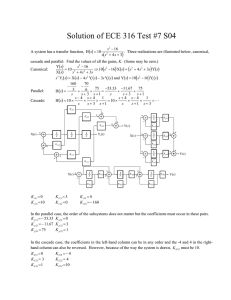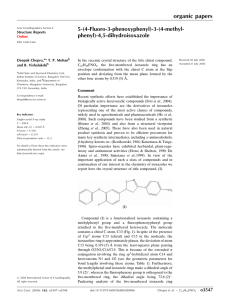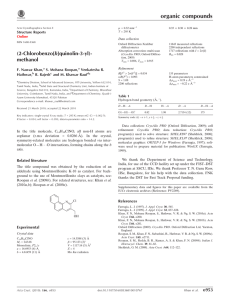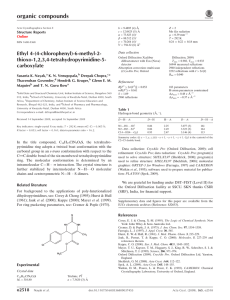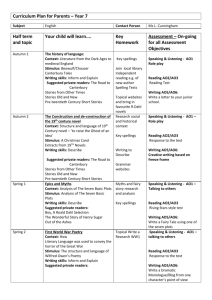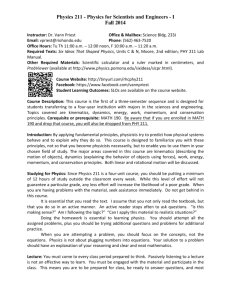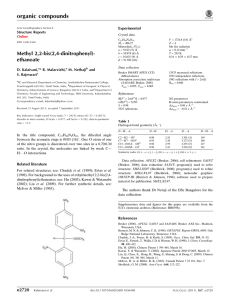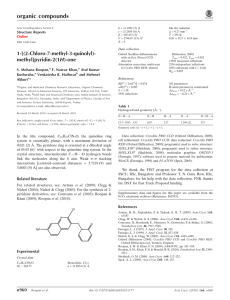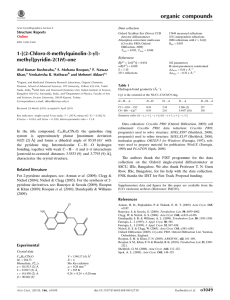Document 13791245
advertisement
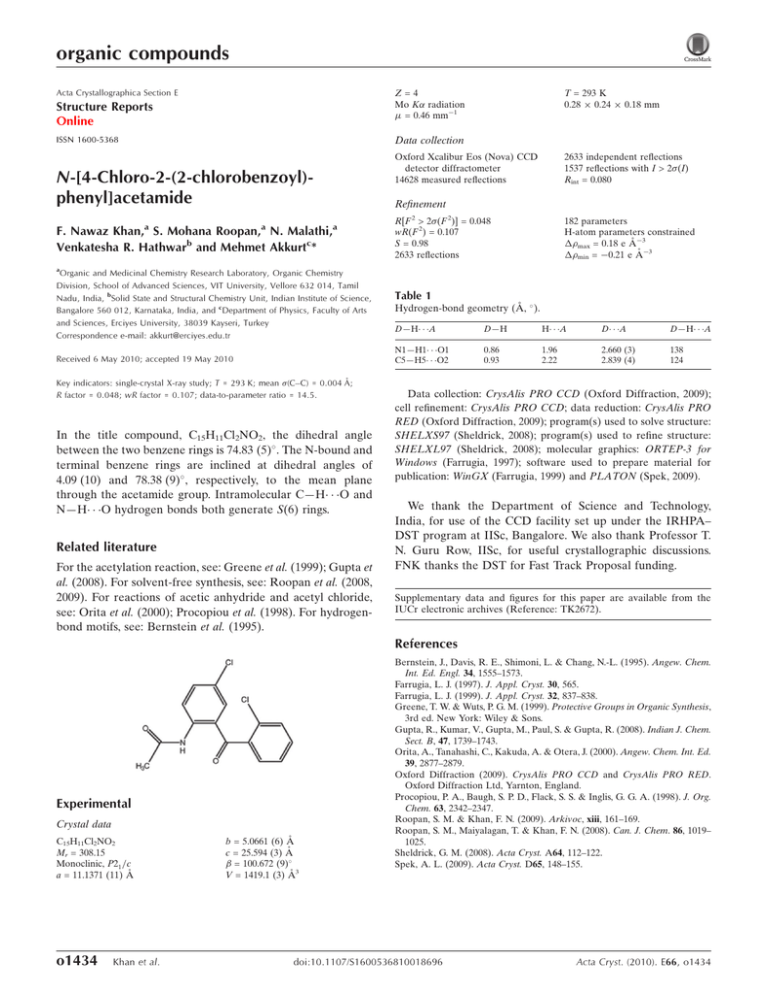
organic compounds Acta Crystallographica Section E Z=4 Mo K radiation = 0.46 mm 1 Structure Reports Online T = 293 K 0.28 0.24 0.18 mm Data collection ISSN 1600-5368 N-[4-Chloro-2-(2-chlorobenzoyl)phenyl]acetamide F. Nawaz Khan,a S. Mohana Roopan,a N. Malathi,a Venkatesha R. Hathwarb and Mehmet Akkurtc* 2633 independent reflections 1537 reflections with I > 2(I) Rint = 0.080 Oxford Xcalibur Eos (Nova) CCD detector diffractometer 14628 measured reflections Refinement R[F 2 > 2(F 2)] = 0.048 wR(F 2) = 0.107 S = 0.98 2633 reflections 182 parameters H-atom parameters constrained max = 0.18 e Å 3 min = 0.21 e Å 3 a Organic and Medicinal Chemistry Research Laboratory, Organic Chemistry Division, School of Advanced Sciences, VIT University, Vellore 632 014, Tamil Nadu, India, bSolid State and Structural Chemistry Unit, Indian Institute of Science, Bangalore 560 012, Karnataka, India, and cDepartment of Physics, Faculty of Arts and Sciences, Erciyes University, 38039 Kayseri, Turkey Correspondence e-mail: akkurt@erciyes.edu.tr Received 6 May 2010; accepted 19 May 2010 Key indicators: single-crystal X-ray study; T = 293 K; mean (C–C) = 0.004 Å; R factor = 0.048; wR factor = 0.107; data-to-parameter ratio = 14.5. In the title compound, C15H11Cl2NO2, the dihedral angle between the two benzene rings is 74.83 (5) . The N-bound and terminal benzene rings are inclined at dihedral angles of 4.09 (10) and 78.38 (9) , respectively, to the mean plane through the acetamide group. Intramolecular C—H O and N—H O hydrogen bonds both generate S(6) rings. Related literature For the acetylation reaction, see: Greene et al. (1999); Gupta et al. (2008). For solvent-free synthesis, see: Roopan et al. (2008, 2009). For reactions of acetic anhydride and acetyl chloride, see: Orita et al. (2000); Procopiou et al. (1998). For hydrogenbond motifs, see: Bernstein et al. (1995). Table 1 Hydrogen-bond geometry (Å, ). D—H A D—H H A D A D—H A N1—H1 O1 C5—H5 O2 0.86 0.93 1.96 2.22 2.660 (3) 2.839 (4) 138 124 Data collection: CrysAlis PRO CCD (Oxford Diffraction, 2009); cell refinement: CrysAlis PRO CCD; data reduction: CrysAlis PRO RED (Oxford Diffraction, 2009); program(s) used to solve structure: SHELXS97 (Sheldrick, 2008); program(s) used to refine structure: SHELXL97 (Sheldrick, 2008); molecular graphics: ORTEP-3 for Windows (Farrugia, 1997); software used to prepare material for publication: WinGX (Farrugia, 1999) and PLATON (Spek, 2009). We thank the Department of Science and Technology, India, for use of the CCD facility set up under the IRHPA– DST program at IISc, Bangalore. We also thank Professor T. N. Guru Row, IISc, for useful crystallographic discussions. FNK thanks the DST for Fast Track Proposal funding. Supplementary data and figures for this paper are available from the IUCr electronic archives (Reference: TK2672). References Experimental Crystal data C15H11Cl2NO2 Mr = 308.15 Monoclinic, P21 =c a = 11.1371 (11) Å o1434 Khan et al. b = 5.0661 (6) Å c = 25.594 (3) Å = 100.672 (9) V = 1419.1 (3) Å3 Bernstein, J., Davis, R. E., Shimoni, L. & Chang, N.-L. (1995). Angew. Chem. Int. Ed. Engl. 34, 1555–1573. Farrugia, L. J. (1997). J. Appl. Cryst. 30, 565. Farrugia, L. J. (1999). J. Appl. Cryst. 32, 837–838. Greene, T. W. & Wuts, P. G. M. (1999). Protective Groups in Organic Synthesis, 3rd ed. New York: Wiley & Sons. Gupta, R., Kumar, V., Gupta, M., Paul, S. & Gupta, R. (2008). Indian J. Chem. Sect. B, 47, 1739–1743. Orita, A., Tanahashi, C., Kakuda, A. & Otera, J. (2000). Angew. Chem. Int. Ed. 39, 2877–2879. Oxford Diffraction (2009). CrysAlis PRO CCD and CrysAlis PRO RED. Oxford Diffraction Ltd, Yarnton, England. Procopiou, P. A., Baugh, S. P. D., Flack, S. S. & Inglis, G. G. A. (1998). J. Org. Chem. 63, 2342–2347. Roopan, S. M. & Khan, F. N. (2009). Arkivoc, xiii, 161–169. Roopan, S. M., Maiyalagan, T. & Khan, F. N. (2008). Can. J. Chem. 86, 1019– 1025. Sheldrick, G. M. (2008). Acta Cryst. A64, 112–122. Spek, A. L. (2009). Acta Cryst. D65, 148–155. doi:10.1107/S1600536810018696 Acta Cryst. (2010). E66, o1434 supporting information supporting information Acta Cryst. (2010). E66, o1434 [doi:10.1107/S1600536810018696] N-[4-Chloro-2-(2-chlorobenzoyl)phenyl]acetamide F. Nawaz Khan, S. Mohana Roopan, N. Malathi, Venkatesha R. Hathwar and Mehmet Akkurt S1. Comment The acetylation of phenol, alcohol and amine are important chemical reactions in organic synthesis (Greene et al., 1999, Gupta et al., 2008). Mainly, acylation of amines is used for the protection of an amino functionality in a multi-step synthetic process. Acetic anhydride and acetyl chloride are generally used in the presence of acidic or basic catalysts in an organic medium (Orita et al., 2000; Procopiou et al., 1998). One of the major factors for a green chemical processes are solvent-free reactions. In continuation of our our interest in this area (Roopan et al., 2008, 2009), we herein report the solvent-free acetylation of an amine, leading to the title compound, (I). Compound (I), Fig. 1, has two chloro-phenyl groups (Cl2/C1–C6 and Cl1/C8–C13) which make a dihedral angle of 74.83 (5)° with each other. The chloro-phenyl groups are inclined at dihedral angles of 4.09 (10) and 78.38 (9) °, respectively, with the mean plane through the acetamide group (N1/O2/C14/C15). The torsion angles O1—C7—C8—C9, O1—C7—C8—C13, C2—C3—C7—O1 and C4—C3—C7—O1 are 109.0 (3), -68.5 (4), 172.8 (3) and -5.8 (4)°, respectively. Two intramolecular, i.e. N1—H1···O1 and C5—H5···O2, hydrogen bonds form six-membered rings, producing S(6) ring motifs (Table 1, Fig. 1, Bernstein et al., 1995). In the crystal structure, there are no classical intermolecular hydrogen bonds. S2. Experimental 2-Amino-5-chloro-phenyl(2-chloro-phenyl)methanone (1 mmol) was stirred with acetyl-chloride (1 mmol) at room temperature for 1 h. The reaction was monitored by TLC. After the completion of the reaction, the contents were cooled and poured onto cold water with stirring. The solid which separated was separated by filtration and dried in air. The dried compound was dissolved in dichloromethane and subjected to slow evaporation to yield single crystals. S3. Refinement All the H atoms were discernible in the difference Fourier maps. However, H atoms were located geometrically with N— H = 0.86 and C—H = 0.93-0.96 Å and refined in the riding model approximation, with Uiso(H) = 1.2 or 1.5Ueq(C, N). Acta Cryst. (2010). E66, o1434 sup-1 supporting information Figure 1 The molecular structure of (I) with the atom numbering scheme. Displacement ellipsoids for non-H atoms are drawn at the 50% probability level. N-[4-Chloro-2-(2-chlorobenzoyl)phenyl]acetamide Crystal data C15H11Cl2NO2 Mr = 308.15 Monoclinic, P21/c Hall symbol: -P 2ybc a = 11.1371 (11) Å b = 5.0661 (6) Å c = 25.594 (3) Å β = 100.672 (9)° V = 1419.1 (3) Å3 Z=4 F(000) = 632 Dx = 1.442 Mg m−3 Mo Kα radiation, λ = 0.71073 Å Cell parameters from 1298 reflections θ = 2.0–20.9° µ = 0.46 mm−1 T = 293 K Block, colourless 0.28 × 0.24 × 0.18 mm Data collection Oxford Xcalibur Eos (Nova) CCD detector diffractometer Radiation source: Enhance (Mo) X-ray Source Graphite monochromator ω scans 14628 measured reflections 2633 independent reflections 1537 reflections with I > 2σ(I) Rint = 0.080 θmax = 25.5°, θmin = 2.7° h = −13→13 k = −6→6 l = −30→30 Refinement Refinement on F2 Least-squares matrix: full R[F2 > 2σ(F2)] = 0.048 wR(F2) = 0.107 S = 0.98 2633 reflections Acta Cryst. (2010). E66, o1434 182 parameters 0 restraints Primary atom site location: structure-invariant direct methods Secondary atom site location: difference Fourier map sup-2 supporting information w = 1/[σ2(Fo2) + (0.0469P)2] where P = (Fo2 + 2Fc2)/3 (Δ/σ)max < 0.001 Δρmax = 0.18 e Å−3 Δρmin = −0.21 e Å−3 Hydrogen site location: inferred from neighbouring sites H-atom parameters constrained Special details Geometry. Bond distances, angles etc. have been calculated using the rounded fractional coordinates. All su's are estimated from the variances of the (full) variance-covariance matrix. The cell esds are taken into account in the estimation of distances, angles and torsion angles Refinement. Refinement on F2 for ALL reflections except those flagged by the user for potential systematic errors. Weighted R-factors wR and all goodnesses of fit S are based on F2, conventional R-factors R are based on F, with F set to zero for negative F2. The observed criterion of F2 > 2sigma(F2) is used only for calculating -R-factor-obs etc. and is not relevant to the choice of reflections for refinement. R-factors based on F2 are statistically about twice as large as those based on F, and R-factors based on ALL data will be even larger. Fractional atomic coordinates and isotropic or equivalent isotropic displacement parameters (Å2) Cl1 Cl2 O1 O2 N1 C1 C2 C3 C4 C5 C6 C7 C8 C9 C10 C11 C12 C13 C14 C15 H1 H2 H5 H6 H10 H11 H12 H13 H15A H15B x y z Uiso*/Ueq 1.01228 (8) 0.68968 (8) 0.94298 (18) 0.5030 (2) 0.7034 (2) 0.6927 (2) 0.8029 (2) 0.8082 (2) 0.6978 (2) 0.5876 (3) 0.5855 (3) 0.9300 (2) 1.0428 (2) 1.0892 (2) 1.1978 (3) 1.2597 (3) 1.2151 (3) 1.1075 (3) 0.6092 (3) 0.6499 (3) 0.77560 0.87480 0.51450 0.51110 1.22820 1.33250 1.25710 1.07860 0.63180 0.73630 0.21348 (16) 0.97146 (17) 0.2513 (5) 0.0779 (5) 0.1634 (5) 0.7372 (6) 0.6603 (5) 0.4689 (5) 0.3551 (5) 0.4396 (6) 0.6267 (6) 0.3982 (6) 0.5175 (5) 0.4451 (5) 0.5487 (6) 0.7314 (7) 0.8101 (7) 0.7045 (6) 0.0330 (6) −0.1678 (7) 0.12130 0.73680 0.36760 0.68050 0.49410 0.80190 0.93660 0.75900 −0.10450 −0.19610 0.05190 (3) 0.00452 (3) 0.19297 (8) 0.17216 (10) 0.17250 (9) 0.05413 (10) 0.08384 (10) 0.12330 (10) 0.13289 (10) 0.10239 (12) 0.06384 (12) 0.15419 (11) 0.13994 (10) 0.09588 (10) 0.08559 (12) 0.11949 (14) 0.16279 (13) 0.17374 (11) 0.18928 (13) 0.23219 (13) 0.18860 0.07750 0.10840 0.04390 0.05590 0.11290 0.18540 0.20380 0.26520 0.23590 0.0676 (3) 0.0706 (3) 0.0777 (9) 0.0936 (11) 0.0533 (9) 0.0477 (10) 0.0429 (9) 0.0396 (9) 0.0431 (10) 0.0580 (11) 0.0566 (11) 0.0459 (10) 0.0399 (9) 0.0435 (10) 0.0565 (11) 0.0661 (13) 0.0686 (12) 0.0586 (11) 0.0607 (12) 0.0775 (16) 0.0640* 0.0510* 0.0700* 0.0680* 0.0680* 0.0790* 0.0820* 0.0700* 0.1160* 0.1160* Acta Cryst. (2010). E66, o1434 sup-3 supporting information H15C 0.60750 −0.33100 0.22290 0.1160* Atomic displacement parameters (Å2) Cl1 Cl2 O1 O2 N1 C1 C2 C3 C4 C5 C6 C7 C8 C9 C10 C11 C12 C13 C14 C15 U11 U22 U33 U12 U13 U23 0.0736 (6) 0.0681 (6) 0.0495 (13) 0.0531 (15) 0.0417 (14) 0.0450 (18) 0.0343 (15) 0.0334 (15) 0.0394 (16) 0.0325 (16) 0.0357 (17) 0.0460 (17) 0.0304 (14) 0.0392 (16) 0.0502 (19) 0.0431 (18) 0.066 (2) 0.060 (2) 0.062 (2) 0.098 (3) 0.0686 (6) 0.0796 (6) 0.117 (2) 0.121 (2) 0.0620 (17) 0.054 (2) 0.0506 (18) 0.0486 (18) 0.0466 (18) 0.077 (2) 0.075 (2) 0.056 (2) 0.0515 (19) 0.0481 (18) 0.064 (2) 0.081 (3) 0.071 (2) 0.071 (2) 0.066 (2) 0.071 (3) 0.0632 (5) 0.0622 (5) 0.0670 (14) 0.109 (2) 0.0590 (16) 0.0428 (16) 0.0446 (16) 0.0367 (15) 0.0446 (16) 0.064 (2) 0.0552 (19) 0.0368 (16) 0.0357 (15) 0.0427 (16) 0.060 (2) 0.072 (2) 0.061 (2) 0.0425 (17) 0.059 (2) 0.071 (2) −0.0187 (5) 0.0248 (5) 0.0078 (13) −0.0246 (16) −0.0031 (13) 0.0096 (15) 0.0030 (13) 0.0029 (13) 0.0048 (14) 0.0005 (16) 0.0166 (16) 0.0067 (15) 0.0058 (14) −0.0041 (14) −0.0023 (17) −0.0194 (19) −0.022 (2) −0.0004 (18) −0.0170 (19) −0.026 (2) 0.0197 (4) 0.0069 (4) 0.0115 (11) 0.0209 (14) 0.0164 (12) 0.0050 (14) 0.0098 (13) 0.0061 (12) 0.0110 (13) 0.0074 (15) −0.0017 (14) 0.0108 (13) 0.0004 (12) 0.0066 (13) 0.0223 (16) 0.0052 (17) −0.0085 (18) 0.0032 (15) 0.0242 (18) 0.035 (2) −0.0213 (4) 0.0221 (5) 0.0456 (14) 0.0138 (17) 0.0079 (14) −0.0018 (14) −0.0003 (15) 0.0003 (14) −0.0019 (15) −0.0017 (19) −0.0033 (18) 0.0062 (15) 0.0049 (14) −0.0055 (14) −0.0031 (17) 0.001 (2) −0.0118 (19) −0.0111 (17) −0.0106 (18) 0.003 (2) Geometric parameters (Å, º) Cl1—C9 Cl2—C1 O1—C7 O2—C14 N1—C4 N1—C14 N1—H1 C1—C6 C1—C2 C2—C3 C3—C4 C3—C7 C4—C5 C5—C6 C7—C8 C8—C13 1.738 (3) 1.734 (3) 1.228 (4) 1.205 (4) 1.397 (3) 1.374 (4) 0.8600 1.382 (4) 1.375 (3) 1.393 (4) 1.420 (3) 1.482 (3) 1.394 (4) 1.365 (4) 1.499 (3) 1.391 (4) C8—C9 C9—C10 C10—C11 C11—C12 C12—C13 C14—C15 C2—H2 C5—H5 C6—H6 C10—H10 C11—H11 C12—H12 C13—H13 C15—H15A C15—H15B C15—H15C 1.374 (3) 1.388 (4) 1.365 (5) 1.356 (5) 1.388 (5) 1.504 (5) 0.9300 0.9300 0.9300 0.9300 0.9300 0.9300 0.9300 0.9600 0.9600 0.9600 Cl1···C2 Cl1···C3 Cl1···Cl1i 3.455 (3) 3.423 (3) 3.3974 (12) C13···O1x C7···H1 C8···H2 3.407 (4) 2.5000 2.4900 Acta Cryst. (2010). E66, o1434 sup-4 supporting information Cl2···C11ii Cl1···H2iii Cl2···H6iv Cl2···H10v O1···N1 O1···C13iii O2···C5 O2···C11vi O1···H13vii O1···H1 O1···H13iii O2···H5 O2···H11vi O2···H12vi O2···H15Aviii N1···O1 C2···Cl1 C2···C9 C3···Cl1 C5···O2 C9···C2 C11···O2ix C11···Cl2ii 3.650 (4) 3.0000 2.9400 3.0500 2.660 (3) 3.407 (4) 2.839 (4) 3.300 (4) 2.7000 1.9600 2.9000 2.2200 2.6100 2.9100 2.8800 2.660 (3) 3.455 (3) 3.330 (3) 3.423 (3) 2.839 (4) 3.330 (3) 3.300 (4) 3.650 (4) C9···H2 C12···H15Axi C14···H5 C15···H12xii H1···O1 H1···C7 H1···H15B H2···Cl1x H2···C8 H2···C9 H5···O2 H5···C14 H6···Cl2iv H10···Cl2v H11···O2ix H12···O2ix H12···C15xiii H13···O1x H13···O1xi H15A···O2xiv H15A···C12vii H15B···H1 2.7700 3.0900 2.7300 2.9500 1.9600 2.5000 2.1100 3.0000 2.4900 2.7700 2.2200 2.7300 2.9400 3.0500 2.6100 2.9100 2.9500 2.9000 2.7000 2.8800 3.0900 2.1100 C4—N1—C14 C14—N1—H1 C4—N1—H1 Cl2—C1—C6 C2—C1—C6 Cl2—C1—C2 C1—C2—C3 C2—C3—C7 C2—C3—C4 C4—C3—C7 N1—C4—C5 C3—C4—C5 N1—C4—C3 C4—C5—C6 C1—C6—C5 O1—C7—C3 C3—C7—C8 O1—C7—C8 C7—C8—C13 C9—C8—C13 C7—C8—C9 C8—C9—C10 Cl1—C9—C8 Cl1—C9—C10 128.8 (2) 116.00 116.00 120.6 (2) 119.9 (3) 119.55 (19) 120.8 (2) 117.8 (2) 119.1 (2) 123.1 (2) 122.4 (2) 118.6 (2) 119.0 (2) 120.9 (3) 120.8 (3) 122.5 (2) 119.9 (2) 117.6 (2) 119.0 (2) 117.5 (2) 123.5 (2) 121.9 (2) 119.76 (18) 118.4 (2) C11—C12—C13 C8—C13—C12 N1—C14—C15 O2—C14—N1 O2—C14—C15 C1—C2—H2 C3—C2—H2 C4—C5—H5 C6—C5—H5 C1—C6—H6 C5—C6—H6 C9—C10—H10 C11—C10—H10 C10—C11—H11 C12—C11—H11 C11—C12—H12 C13—C12—H12 C8—C13—H13 C12—C13—H13 C14—C15—H15A C14—C15—H15B C14—C15—H15C H15A—C15—H15B H15A—C15—H15C 120.8 (3) 120.3 (3) 114.2 (3) 123.4 (3) 122.4 (3) 120.00 120.00 120.00 120.00 120.00 120.00 120.00 120.00 120.00 120.00 120.00 120.00 120.00 120.00 109.00 110.00 109.00 109.00 109.00 Acta Cryst. (2010). E66, o1434 sup-5 supporting information C9—C10—C11 C10—C11—C12 119.4 (3) 120.0 (3) H15B—C15—H15C 110.00 C14—N1—C4—C3 C14—N1—C4—C5 C4—N1—C14—O2 C4—N1—C14—C15 Cl2—C1—C2—C3 C6—C1—C2—C3 Cl2—C1—C6—C5 C2—C1—C6—C5 C1—C2—C3—C4 C1—C2—C3—C7 C2—C3—C4—N1 C2—C3—C4—C5 C7—C3—C4—N1 C7—C3—C4—C5 C2—C3—C7—O1 C2—C3—C7—C8 C4—C3—C7—O1 C4—C3—C7—C8 178.3 (3) −1.6 (4) −3.1 (5) 178.4 (3) −178.8 (2) 0.9 (4) 179.1 (2) −0.6 (4) −0.6 (4) −179.3 (2) −180.0 (2) −0.1 (4) −1.3 (4) 178.5 (3) 172.8 (3) −4.3 (4) −5.8 (4) 177.1 (2) N1—C4—C5—C6 C3—C4—C5—C6 C4—C5—C6—C1 O1—C7—C8—C9 O1—C7—C8—C13 C3—C7—C8—C9 C3—C7—C8—C13 C7—C8—C9—Cl1 C7—C8—C9—C10 C13—C8—C9—Cl1 C13—C8—C9—C10 C7—C8—C13—C12 C9—C8—C13—C12 Cl1—C9—C10—C11 C8—C9—C10—C11 C9—C10—C11—C12 C10—C11—C12—C13 C11—C12—C13—C8 −179.7 (3) 0.4 (4) −0.1 (5) 109.0 (3) −68.5 (4) −73.8 (4) 108.7 (3) 2.8 (4) −176.2 (3) −179.7 (2) 1.4 (4) 177.2 (3) −0.4 (4) 179.8 (2) −1.2 (4) 0.0 (5) 0.9 (5) −0.7 (5) Symmetry codes: (i) −x+2, −y, −z; (ii) −x+2, −y+2, −z; (iii) x, y−1, z; (iv) −x+1, −y+2, −z; (v) −x+2, −y+1, −z; (vi) x−1, y−1, z; (vii) −x+2, y−1/2, −z+1/2; (viii) −x+1, y+1/2, −z+1/2; (ix) x+1, y+1, z; (x) x, y+1, z; (xi) −x+2, y+1/2, −z+1/2; (xii) −x+2, y−3/2, −z+1/2; (xiii) −x+2, y+3/2, −z+1/2; (xiv) −x+1, y−1/2, −z+1/2. Hydrogen-bond geometry (Å, º) D—H···A D—H H···A D···A D—H···A N1—H1···O1 C5—H5···O2 0.86 0.93 1.96 2.22 2.660 (3) 2.839 (4) 138 124 Acta Cryst. (2010). E66, o1434 sup-6

